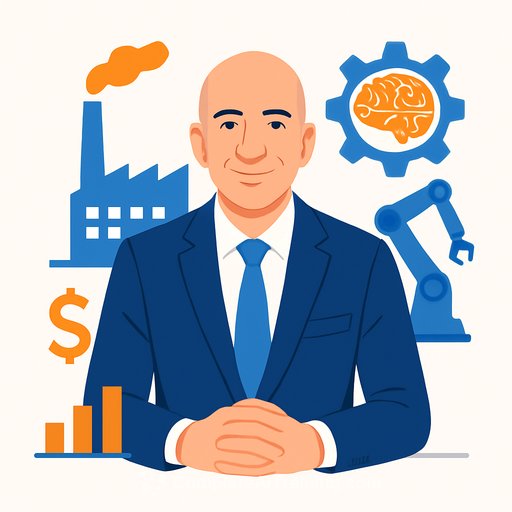Jeff Bezos to co-lead Project Prometheus: AI aimed at industrial-scale manufacturing
Jeff Bezos is reportedly stepping into a new operational role as co-CEO of Project Prometheus, a well-funded AI startup focused on improving manufacturing for computers, cars, and spacecraft. Early reports say the company has raised around $6.2 billion, with Bezos contributing and helping to run the effort.
He'll share the role with co-founder Vik Bajaj, a physicist and chemist who previously worked at Google X before leading Verily under Alphabet. The team has nearly 100 people already, including talent from OpenAI, DeepMind, and Meta.
This marks Bezos's first formal operating position since stepping down as Amazon CEO in 2021. It also follows renewed momentum at Blue Origin, which recently achieved a successful New Glenn booster landing in its orbital program.
Why this matters for engineers and technical leaders
If Project Prometheus is targeting manufacturing at scale, expect heavy investment in AI that meets real-world constraints: uptime, yield, safety, latency, traceability. This isn't research theater. It's the kind of work where a 0.3% improvement can be worth millions.
The hiring signal (OpenAI/DeepMind/Meta alumni) suggests large-model expertise paired with applied robotics, controls, and vision. The budget signals ambition: proprietary datasets, simulation infrastructure, and potentially custom tooling for factory-grade deployment.
Likely technical focus areas
- Industrial vision and defect detection: Multimodal models for visual, acoustic, and thermal signals; few-shot adaptation across product lines; synthetic data and domain randomization to close sim-to-real gaps.
- Digital twins and process optimization: Closed-loop systems that link CAD/CAM, MES, and real-time sensor data; scenario testing before changes hit the line; model predictive control for throughput and yield.
- Edge inference at low latency: Compressed models deployed on GPUs, edge TPUs, or FPGAs; strict SLA for inference and deterministic behavior; fallbacks and graceful degradation when networks drop.
- Robotics and automation: ROS 2-centric stacks, motion planning with safety envelopes, reinforcement learning with human-in-the-loop guardrails, and teleoperation for rare events.
- Controls + time-series intelligence: Forecasting for tool wear, drift, and out-of-spec dynamics; adaptive control informed by state estimation (e.g., Kalman variants) and uncertainty-aware models.
- Factory integration: PLC/SCADA interoperability (OPC UA, MQTT, Modbus), strict change management, versioned deployments, and end-to-end audit trails for compliance.
What the funding implies
$6.2B gives room to build the unglamorous pieces that make or break industrial AI: data contracts with OEMs, labeling pipelines, on-prem orchestration, and long-term support. It could also finance large-scale simulation environments and custom evaluation frameworks aligned to safety and quality standards.
Target sectors-computing, automotive, aerospace-favor teams that can thread AI into existing systems without downtime. Expect emphasis on reliability, qualification, and certifications alongside model performance.
Practical steps for developers and architects
- Skill stack to sharpen: PyTorch/JAX, ONNX/TensorRT, time-series modeling, model predictive control, ROS 2, computer vision for manufacturing, and secure edge deployment.
- Industrial standards to know: OPC UA, ISA-95, IEC 61508 (functional safety), ISO 26262 (automotive), and cybersecurity frameworks for OT.
- Data engineering: High-frequency sensor ingestion, timestamp alignment, schema contracts, cold-start strategies, and labeling with weak supervision and QA loops.
- Testing and reliability: Simulation-first development, domain randomization, shadow deployments, canary rollouts, and human-in-the-loop review for non-stationary processes.
- Observability: Unified telemetry for models and machines; drift detection, retraining triggers, and traceable decisions for audits.
How to prepare your org
- Make your data usable: Map critical lines, define metrics (yield, cycle time, OEE), and establish clean data pathways from PLCs to a central store with retention and governance.
- Start with a narrow, high-ROI slice: One station, one defect type, one bottleneck. Prove lift, then scale across stations and plants.
- Plan for edge reality: Network constraints, device failures, and operator workflows. Your model is part of a system, not the system.
- Include safety and compliance early: Document assumptions, decision bounds, and failure modes. Align with EHS and quality teams before pilots.
According to The New York Times, Project Prometheus is already among the best-funded early-stage startups. If that capital translates into dependable factory outcomes, expect pressure on vendors across MES, vision, and robotics to integrate-or get outpaced.
Need to upskill for industrial AI?
If you're moving from web-scale to factory-scale systems, it's a different set of constraints and checklists. Build the stack now so you're not reacting later.
- AI courses by skill for MLOps, computer vision, and data engineering.
- Coding-focused AI certification to formalize deployment practices.
Bottom line: strong team, serious funding, and a hard problem space. For engineers, the opportunity sits where models meet machines-and where reliability pays the bills.
Your membership also unlocks:






